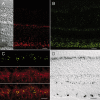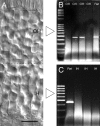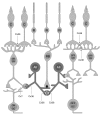Expression of connexin36 in cone pedicles and OFF-cone bipolar cells of the mouse retina
- PMID: 15056712
- PMCID: PMC6730041
- DOI: 10.1523/JNEUROSCI.5598-03.2004
Expression of connexin36 in cone pedicles and OFF-cone bipolar cells of the mouse retina
Abstract
Transgenic technology, immunocytochemistry, electrophysiology, intracellular injection techniques, and reverse transcription PCR were combined to study the expression of neuronal connexin36 (Cx36) in the outer plexiform layer of the mouse retina. Transgenic animals expressed either a fusion protein of full-length Cx36 with enhanced green fluorescent protein (EGFP) attached at the C terminus or exon 2 of Cx36 was replaced bybeta-galactosidase (beta-gal). In the outer nuclear layer,beta-gal-positive cell bodies, which were confined to the most distal region close to the outer limiting membrane, displayed immunoreactivity against S-cone opsin. Cx36-EGFP puncta colocalized with cone pedicles, which were visualized by intracellular injection. In reverse transcriptase PCR experiments, Cx36 mRNA was never detected in samples of rods harvested from the outer nuclear layer. These results strongly suggest expression of Cx36 in cones but not in rods. In vertical sections, Cx36 expression in the vitreal part of the outer plexiform layer was characterized by a patchy distribution. Immunocytochemistry with antibodies against the neurokinin-3 receptor and the potassium channel HCN4 (hyperpolarization-activated cyclic nucleotide-gated potassium channel) displayed clusters of the Cx36 label on the dendrites of OFF-cone bipolar cells. In horizontal sections, these clusters of Cx36 appeared as round or oval-shaped groups of individual puncta, and they were always aligned with the base of cone pedicles. Double-labeling experiments and single-cell reverse transcriptase PCR ruled out expression of Cx36 in horizontal cells and rod bipolar cells. At light microscopic resolution, we found close association of Cx36-EGFP with the AMPA-type glutamate receptor subunit GluR1 but not with GluR2-GluR4, the kainate receptor subunit GluR5, or the metabotropic glutamate receptor mGluR6.
Figures









Similar articles
-
Expression of genes encoding glutamate receptors and transporters in rod and cone bipolar cells of the primate retina determined by single-cell polymerase chain reaction.Mol Vis. 2007 Nov 28;13:2194-208. Mol Vis. 2007. PMID: 18087239
-
Expression of neuronal connexin36 in AII amacrine cells of the mammalian retina.J Neurosci. 2001 Jan 1;21(1):230-9. doi: 10.1523/JNEUROSCI.21-01-00230.2001. J Neurosci. 2001. PMID: 11150340 Free PMC article.
-
Selective synaptic distribution of AMPA and kainate receptor subunits in the outer plexiform layer of the carp retina.J Comp Neurol. 2001 Jul 9;435(4):433-49. doi: 10.1002/cne.1042. J Comp Neurol. 2001. PMID: 11406824
-
Localization of kainate receptors at the cone pedicles of the primate retina.J Comp Neurol. 2001 Aug 6;436(4):471-86. doi: 10.1002/cne.1081. J Comp Neurol. 2001. PMID: 11447590
-
The Cold Case of Metabotropic Glutamate Receptor 6: Unjust Detention in the Retina?Curr Neuropharmacol. 2020;18(2):120-125. doi: 10.2174/1570159X17666191001141849. Curr Neuropharmacol. 2020. PMID: 31573889 Free PMC article. Review.
Cited by
-
Rod and cone contributions to horizontal cell light responses in the mouse retina.J Neurosci. 2008 Jul 2;28(27):6818-25. doi: 10.1523/JNEUROSCI.1564-08.2008. J Neurosci. 2008. PMID: 18596157 Free PMC article.
-
AII amacrine cells discriminate between heterocellular and homocellular locations when assembling connexin36-containing gap junctions.J Cell Sci. 2014 Mar 15;127(Pt 6):1190-202. doi: 10.1242/jcs.133066. Epub 2014 Jan 24. J Cell Sci. 2014. PMID: 24463820 Free PMC article.
-
Role of connexin channels in the retinal light response of a diurnal rodent.Front Cell Neurosci. 2014 Aug 25;8:249. doi: 10.3389/fncel.2014.00249. eCollection 2014. Front Cell Neurosci. 2014. PMID: 25202238 Free PMC article.
-
Loss of Gap Junction Delta-2 (GJD2) gene orthologs leads to refractive error in zebrafish.Commun Biol. 2021 Jun 3;4(1):676. doi: 10.1038/s42003-021-02185-z. Commun Biol. 2021. PMID: 34083742 Free PMC article.
-
Loss of protein kinase Cgamma in knockout mice and increased retinal sensitivity to hyperbaric oxygen.Arch Ophthalmol. 2009 Apr;127(4):500-6. doi: 10.1001/archophthalmol.2009.31. Arch Ophthalmol. 2009. PMID: 19365031 Free PMC article.
References
-
- Benardo LS (1997) Recruitment of GABAergic inhibition and synchronization of inhibitory interneurons in rat neocortex. J Neurophysiol 77: 3134–3144. - PubMed
-
- Blanks JC, Johnson LV (1983) Selective lectin binding of the developing mouse retina. J Comp Neurol 221: 31–41. - PubMed
-
- Brandstätter JH, Löhrke S, Morgans CW, Wässle H (1996) Distributions of two homologous synaptic vesicle proteins, synaptoporin and synaptophysin, in the mammalian retina. J Comp Neurol 370: 1–10. - PubMed
-
- Brandstätter JH, Fletcher EL, Garner CC, Gundelfinger ED, Wässle H (1999) Differential expression of the presynaptic cytomatrix protein bassoon among ribbon synapses in the mammalian retina. Eur J Neurosci 11: 3683–3693. - PubMed
Publication types
MeSH terms
Substances
LinkOut - more resources
Full Text Sources
Other Literature Sources
Molecular Biology Databases
